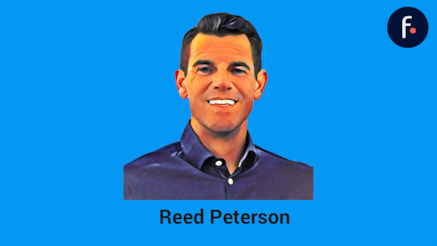Titans of Telecoms:
“The data race is now on”

Our Titans have been working for 25+ years. Now they look ahead to the next 25. Where might the telecoms industry be in 2047 and what might it take to get there? We speak to former T-Mobile CIO and president and founder of CJL Consulting, Cody Sanford.
If the past couple of years have taught us anything, predicting what’s going to happen in the next 12 months is challenging enough, let alone the next 25 years. However, for Cody Sanford, an industry veteran who cut his teeth in wireless consultancy in the mid-90s, predicting the future is part of the job description.
Sanford, who started out securing licenses and building networks for clients such as AT&T International in Ireland, has a unique insight into the history of cellular networks. His time at T-Mobile as chief information product officer only added to the rich layers of knowledge of what makes the industry tick. So, he’s as well placed to give some insight into what communications service providers (CSPs) can expect in the coming years.
The key to the future is in the engine room
Inevitably, there is talk of the metaverse, the virtual worlds inspired by 90s cyberpunk classic novel Snow Crash. Sanford acknowledges the growing interest in and the potential of the metaverse, but he is much more interested in the engine room. For Sanford, the future for CSPs is all about networks and data, and therein lies both the opportunity and the challenge. While CSPs have enjoyed years of growth on the back of wireless and internet access, through 4G and now 5G, there is an increasing need – and desire – for transformation.
“They are trying hard to redefine what they represent and who they are culturally,” says Sanford. “Very few wireless companies have achieved relevance in other dimensions, through innovation, for example. Most of it has been done through others. I think it's easy to argue that Apple and Google have had more to do with the evolution of technology in our lives than the wireless companies. It's kind of a chicken and egg, but despite their best efforts, wireless businesses have culturally been bound by their history, which is understandable.”
That said, Sanford is seeing progress and change. Wireless CSPs want to evolve, but often do not know how to, at least efficiently and effectively. If they are going to be relevant for years to come, they have to adapt, to become masters of their own destiny, so to speak. So, where is that destiny? What key trends does Sanford see emerging in the coming years?
“What 4G and 5G are unlocking is this proximity technology to the body,” he says, “and the next 25 years will be a continued extension of that. For example, the metaverse. Immersion is a natural extension of proximity. Think virtual reality and the ability to be virtual anywhere or augmented anywhere through glasses.”
Sanford also talks about applications such as driverless cars – “the capability to make that happen today from a telco perspective is already there, we just need the rest of the other industries to catch up” – healthcare, logistics and in particular agriculture, where he sees huge progress in terms of telemetry. There will be others too, that we haven’t really thought about yet, but the underlying change will be how data is processed and managed.
CSPs already have a wealth of data. The challenge facing CSPs, says Sanford, is how to manage that data better, to get it closer to the applications and to use it more intelligently, to drive customer experiences, innovation and relevance. This is key, he adds, to enabling applications such as the metaverse and driverless vehicles.
“The CSPs are probably the worst offenders of having immense troves of consumer and enterprise data and not doing anything with it,” says Sanford, who has worked with DataStax on trying to help businesses scale their data and use it more intelligently. “They have been horrible stewards – not stewards in terms of privacy, but stewards in terms of letting it just sit there.”
Could that change? Is Sanford seeing any hint of progress?
“I do believe they are thinking about data as a monetizable asset and doing it in a way that brings value to consumers and enterprises,” he says. “There are teams of people trying to figure out what that looks like and then also figure out how to fix their architecture to actually make that possible. And as you know, that is remarkably hard to do, and in big legacy environments too, but they have to be creative, make the data usable, connect it and create context and then they need to be able to figure out how to expose it at scale. CSPs need to become product companies.”
A customer-centric approach is essential
For Sanford, this is the future for wireless CSPs. He talks about great products being “the most empathetically connected to what the consumers want the most,” and says CSPs have to get their head around that concept. It’s a cultural as well as a data challenge, one that shouldn’t take another 25 years to achieve.
“You know, chief data officers are being brought in whose only job is to manage, curate and expose data for the benefit of the company. For the CSPs, I think it's going to take some time for that to marinate and generate some flavor.”
However, to realize the potential, Cody believes CSPs need a cultural shift. He says they are still struggling to shake off their past, to emerge into the present and build a more dynamic, customer-centric future. They need to start thinking differently and using their resources that, so far, have not been utilized to their full potential.
“Much of the issues that arise within CSPs today are rooted in history,” says Sanford. “For the most part, the industry has been run by utilities and treated as such. Phone companies traditionally make money from selling capacity. It is cultural. They build outside plant. They deliver a capacity to the end user and that end user then uses other people's products on the telco’s infrastructure.”
For Sanford, this has been a model that made perfect sense, with CSPs focusing on core competencies and then partnering with third parties to create experiences and to serve the specific needs of consumers and businesses. He should know, because he has worked in the industry helping CSPs set up these models. It’s where he began, sort of. But now he believes there has to be change.
“When I started it was a bit like the wild west,” he says. “It was exciting. Now CSPs need to figure out how to use their data better, to build applications around that data. How do you get the data closer to the applications? How do you innovate and evolve, using data to generate new ideas that can excite customers and deliver more value to the business? For CSPs, the race is now on.”


